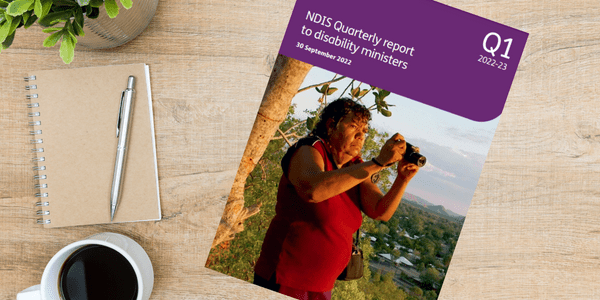
The National Disability Insurance Agency (NDIA) recently released its first quarterly report for the new financial year, detailing its performance and operations from 1 July 2022 to 30 September 2022.
At over 800 pages the quarterly report contains a wide range of NDIS data, providing commentary about the Scheme’s progress, successes and challenges and providing insights on the Agency’s priorities.
According to the report, over the past three months in addition to all its usual activities, the NDIA has been focusing on:
- Continued support for participants, providers, staff and partners during the COVID-19 pandemic. The NDIA has continued to deliver COVID-19 response measures to participants, providers, staff and partners to ensure the continuity of safe services during the pandemic.
- Co-design projects designed to strengthen the NDIA’s engagement process. This quarter the NDIA presented a communications and engagement plan to the Co-design Advisory Group that provides a framework for building co-design and engagement knowledge and capability.
- Impact of the NDIS legislation amendments that came into effect on 1 July 2022. The NDIA has continued implementing changes introduced by the National Disability Insurance Scheme Amendment (Participant Service Guarantee and Other Measures) Bill 2022.
- Improving the experience of participants. The NDIA remains focused on improving the experience of participants especially surrounding employment opportunities, assisting participants to leave hospital and reducing the number of cases at the Administrative Appeals Tribunal (AAT).
- Leadership appointments. Australian Paralympian and disability advocate Kurt Fearnley AO was appointed Chairman of the NDIA Board and commenced on 18 October 2022. The NDIA Board also welcomed new members Dr Graeme Innes AM and Ms Maryanne Diamond AO. Rebecca Falkingham PSM was appointed as CEO of the NDIA and commenced on 18 October 2022.
What did this quarter look like for participants and their plans?
The NDIS Quarterly Report shows there are now 554,917 Australians with disability receiving NDIS support, with 23,137 new participants joining the NDIS this quarter – a 4% increase from last quarter.
Of the new participants, 9.4% identified as First Nations Australians and 8.9% identified as being from a Culturally and Linguistically Diverse community.
Further, the NDIA undertook 78,533 plan reassessments in the quarter, averaging 5,975 reassessments per week. Of the 78,533 plan reassessments conducted, 57,235 were initiated by the Agency and 21,298 were requested by participants. Agency-initiated plan reassessments (AIPR) occur as plans are due to expire and a new plan is required.
The YPIRAC Targets
The Joint Agency Taskforce (JATF) between DSS, Department of Health and Aged Care (DOHAC) and the NDIA, continues to work towards achieving the Younger People in Residential Aged Care (YPIRAC) targets.
The report shows that as of 30 September 2022, 604 younger people in residential aged care have a goal to leave residential aged care, including 28 under the age of 45. As at 30 September 2022, there were 1,732 NDIS participants under the age of 65 without a current goal to move.
The NDIA states that it will continue to work closely with DSS, DOHAC and disability community and sector representatives to achieve the YPIRAC targets and ensure no younger person lives in residential aged care unless there are exceptional circumstances.
Participation in work (percentage in a paid job)
The report states the NDIA is maintaining a strong focus on employment outcomes for NDIS participants but, according to the figures, much still needs to be done.
Looking at all participants who are of working age (15 to 64), the percentage of participants in work has increased slightly from 20 per cent to 21 per cent for those who have been in the Scheme for two years. There has been a decrease of one percentage point for participants who have been in the Scheme for six years (from 20 per cent to 19 per cent)
According to the report, an important focus for the NDIA in 2023 will be delivering on the commitment arising from the NDIA Jobs and Skills forum, to build explicit discussion about employment as a goal into the planning process and to ensure participants who want to work are supported to do so through their plans and other government services.
Satisfaction with the Scheme
This quarter, 85% of participants rated the Planning process as either good or very good, with a further 9% rating the experience as neutral. Eighty-one per cent of the participants in the quarter rated the Access process as either good or very good, 80% rated the Pre-Planning process as either good or very good, and 69% of participants rated the Plan Reassessment process as either good or very good. These results are based on 1,133 surveys at Access, 1,021 at Pre-Planning, 4,867 at Planning and 10,852 at Reassessment, which is 17,873 in total.
The surveys also include questions that provide further insights at each stage of the pathway. The results indicate that satisfaction for the September 2022 quarter is comparable to prior quarters for most questions, although satisfaction declined slightly in relation to Plan Reassessment.
Participant Service Improvement Plan (SIP) – Commitments and Progress
The NDIA introduced a refreshed Service Improvement Plan (SIP) for 2022-23 to ensure it closely reflected the improvements participants want to see. The SIP sets out what the NDIA will do over the next two years to deliver a Scheme that meets participant expectations – outlining 51 commitments to be delivered over the next two years. The refreshed SIP includes new and refined commitments, representing the NDIA’s ongoing commitment to participants, their families and carers and the disability community
NDIA’s new Information and Communication Technology (ICT) business system
The NDIA’s new ICT business system – PACE – which is being built to improve the end-to-end participant journey and planning process – is on track to replace the NDIA’s current CRM, portal and payment systems.
PACE is being designed to be more user-friendly and make it easier for NDIA staff and partners to do their job, giving them more time to deliver a quality experience for participants and providers.
NDIA staff have now started testing features of the PACE system. This process will continue over the coming months. In addition, the planning for a real-time test of the PACE system has started, with testing to commence in Tasmania by November 2022. The real-time test will involve NDIA staff and Partners in the Community (PITC) Program staff using the new system with current and prospective participants, providers and the wider disability community.
You can access the full Quarterly report 2022-23 Q1 as well as view state-specific information about the NDIS performance and the national dashboard here.



